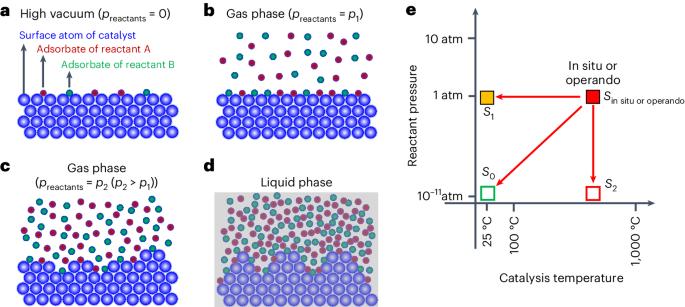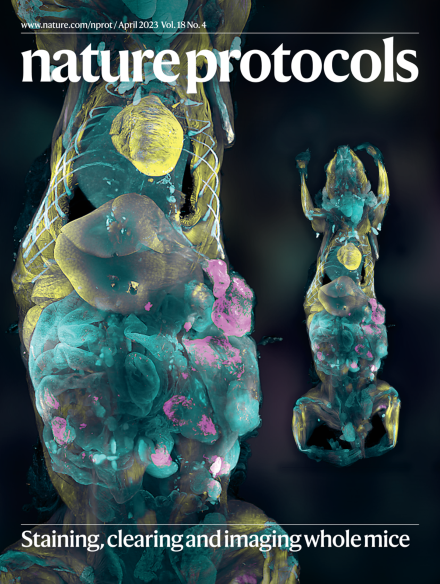用x射线光电子能谱仪在大气压下对液体或气体中纳米颗粒表面进行光电子能谱研究。
IF 16
1区 生物学
Q1 BIOCHEMICAL RESEARCH METHODS
引用次数: 0
摘要
纳米催化剂的表面化学性质对于理解对化学转化、能量转换和环境可持续性具有重要意义的反应的催化机制至关重要。为了使高真空x射线光电子能谱(XPS)系统能够使用差分泵浦能量分析仪表征液体或气相中的纳米颗粒表面,需要对高真空XPS仪器进行重大和实质性的修改。在本协议中,我们描述了一种基于膜分离细胞的XPS方法,该方法允许表征分散在流动液体或气体(2bar)中的催化剂纳米颗粒的表面,而无需对高真空x射线光电子能谱仪进行任何仪器修改。该电池采用双层石墨烯膜,将催化剂及其反应环境与高真空XPS系统的高真空环境分开。石墨烯膜被组装在改性氮化硅窗口的孔上,允许x射线束激发液体或气体中催化剂表面原子的亚壳层电子,并允许被激发的电子转移到高真空环境中进行XPS分析。该方案描述了如何在氮化硅窗口中创建一个孔,制备和加载石墨烯层来密封孔,将密封窗口组装到细胞帽上,将催化剂纳米颗粒引入细胞帽,将细胞帽安装到细胞体上形成一个完整的细胞,将完整的细胞组装到高真空XPS系统中,在细胞内固液或固气界面进行的催化或体内/体外生物过程中,流动液体或气体通过细胞并收集光电子。设备和部件设置需要2-5天,数据收集需要12-24小时。本协议示例了在流动液体中对Ag纳米粒子进行C-C偶联的操作研究,以及在0.4 bar CO和1.6 bar O2的流动混合物中对Ni/TiO2纳米粒子进行CO氧化。本文章由计算机程序翻译,如有差异,请以英文原文为准。

Photoelectron spectroscopic operando studies of surface of nanoparticles in liquid or gas at bar pressure with an X-ray photoelectron spectrometer
The surface chemistry of catalyst nanoparticles is crucial for understanding catalytic mechanisms of reactions significant for chemical transformation, energy conversion and environmental sustainability. To enable a high-vacuum X-ray photoelectron spectroscopy (XPS) system to characterize nanoparticle surfaces in liquid or gas phase using a differentially pumped energy analyzer, major and substantial modifications to the high-vacuum XPS instrumentation are required. In this protocol we describe a membrane-separated cell-based XPS approach that allows characterization of the surface of catalyst nanoparticles dispersed in a flowing liquid or gas (at 2 bar) without any instrumental modification to a high-vacuum X-ray photoelectron spectrometer. The cell features a double-layer graphene membrane that separates a catalyst and its reaction environment from the high-vacuum environment of the high-vacuum XPS system. The graphene membrane is assembled onto the pore of a modified Si3N4 window of the cell, admitting an X-ray beam to excite subshell electrons of the catalyst surface atoms in liquid or gas and allowing excited electrons to transit to the high-vacuum environment for XPS analysis. This protocol describes how to create a pore in a Si3N4 window, prepare and load graphene layers to seal the pore, assemble the sealed window onto a cell cap, introduce catalyst nanoparticles to the cell cap, install the cell cap to a cell body to form a complete cell, assemble the complete cell to the high-vacuum XPS system, flow liquid or gas through the cell and collect photoelectrons during catalysis or in vivo/in vitro biological processes performed at solid–liquid or solid–gas interfaces in the cell. Equipment and parts setup takes 2–5 d and data collection takes 12–24 h. This protocol examples the operando studies of C–C coupling on Ag nanoparticles performed in flowing liquid and CO oxidation on Ni/TiO2 nanoparticles in flowing mixture of 0.4 bar CO and 1.6 bar O2. The surface features of nanoparticle catalysts change during a reaction. This protocol describes how to measure these changes in operando (in flowing liquid or gas) by X-ray photoelectron spectrometry using a modified Si3N4 window.
求助全文
通过发布文献求助,成功后即可免费获取论文全文。
去求助
来源期刊

Nature Protocols
生物-生化研究方法
CiteScore
29.10
自引率
0.70%
发文量
128
审稿时长
4 months
期刊介绍:
Nature Protocols focuses on publishing protocols used to address significant biological and biomedical science research questions, including methods grounded in physics and chemistry with practical applications to biological problems. The journal caters to a primary audience of research scientists and, as such, exclusively publishes protocols with research applications. Protocols primarily aimed at influencing patient management and treatment decisions are not featured.
The specific techniques covered encompass a wide range, including but not limited to: Biochemistry, Cell biology, Cell culture, Chemical modification, Computational biology, Developmental biology, Epigenomics, Genetic analysis, Genetic modification, Genomics, Imaging, Immunology, Isolation, purification, and separation, Lipidomics, Metabolomics, Microbiology, Model organisms, Nanotechnology, Neuroscience, Nucleic-acid-based molecular biology, Pharmacology, Plant biology, Protein analysis, Proteomics, Spectroscopy, Structural biology, Synthetic chemistry, Tissue culture, Toxicology, and Virology.
 求助内容:
求助内容: 应助结果提醒方式:
应助结果提醒方式:


